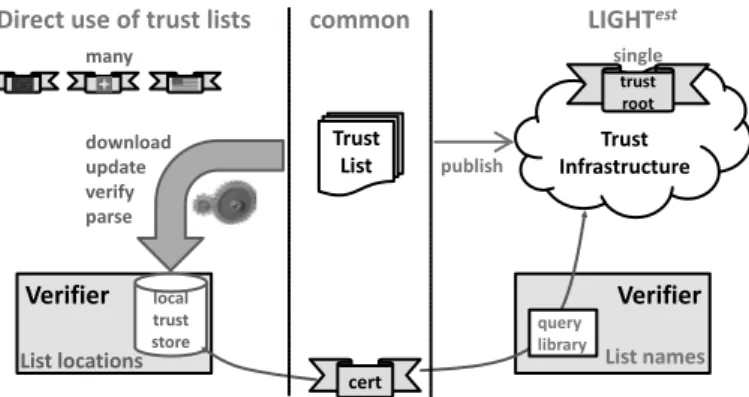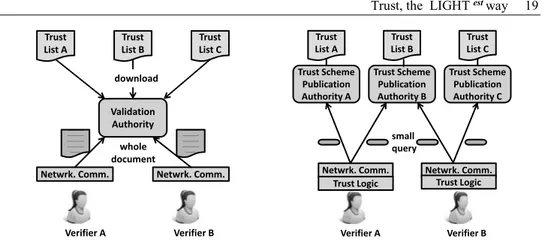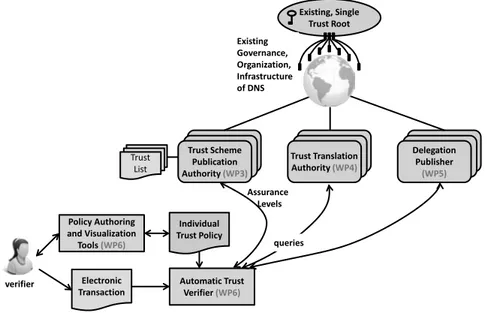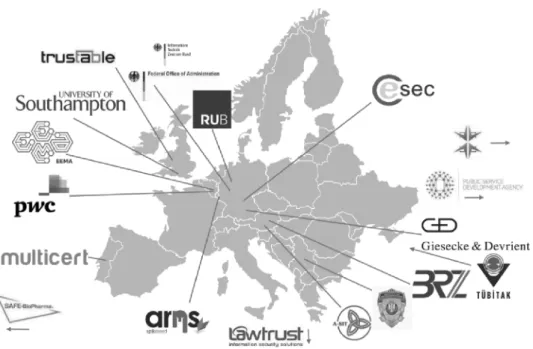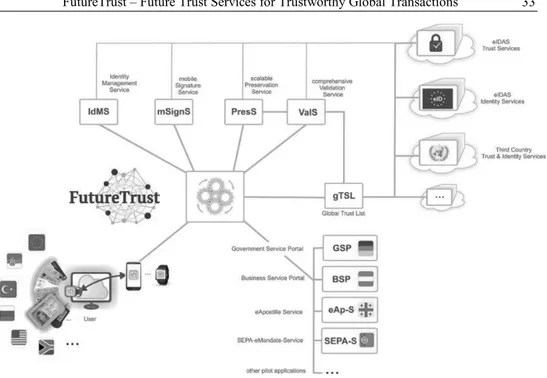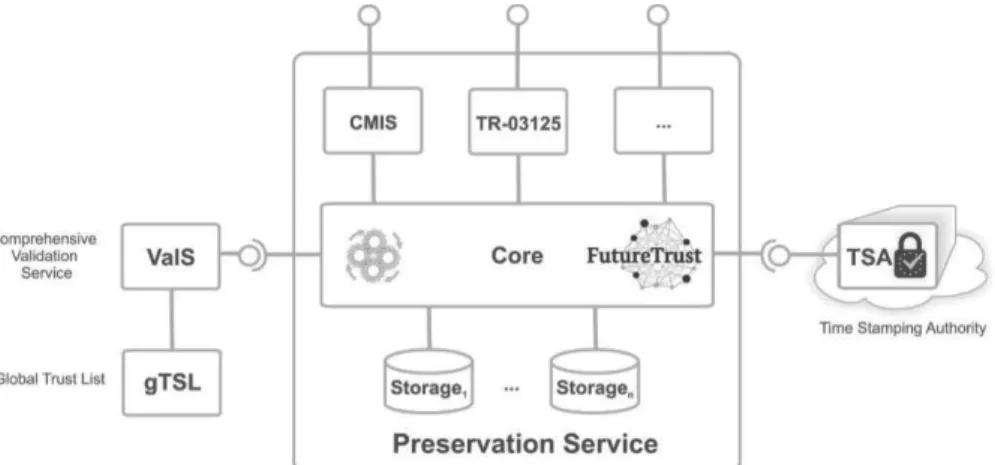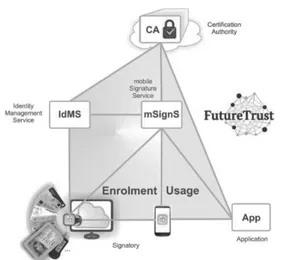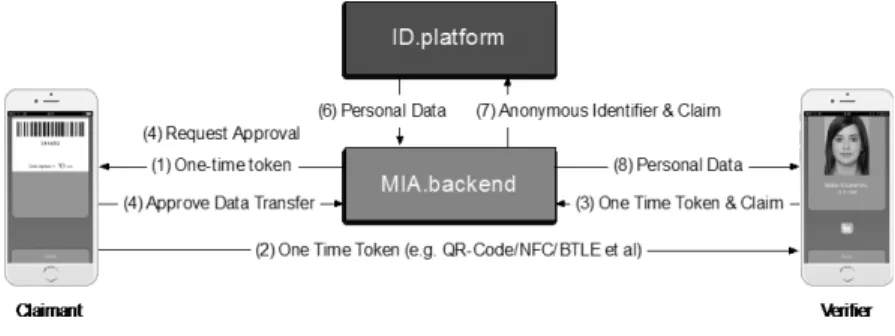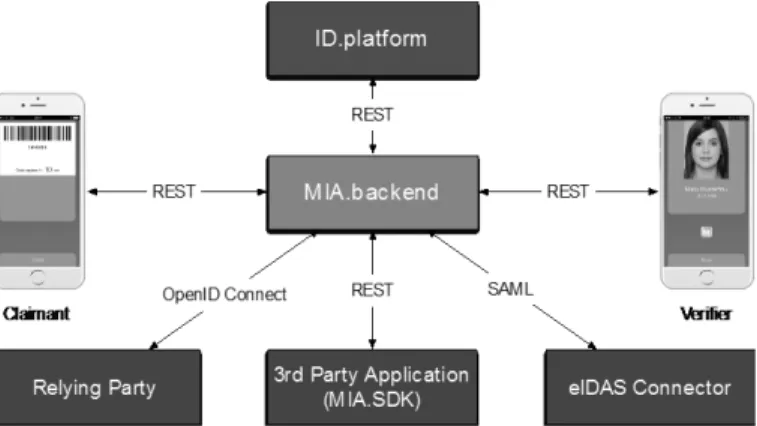Open standards and interfaces as well as open source technologies play a central role in the current identity management landscape as well as in emerging future scenarios such as Internet of Things enabled healthcare and global infrastructures for trust man- agement. While there are already plenty of successful applications in which those techniques are used to safeguard the authenticity, integrity and confidentiality, there are still many closely related areas which demand further research. The aim of the
“Open Identity Summit 2016” is to link practical experiences with academic innova- tions. Focus areas of this event are research and applications in the area of Identity Management, Policy Implementation, Privacy by Design, Trust Services, and Mobile ID.
ISSN 1617-5468
ISBN 978-3-88579-658-9
Gesellschaft für Informatik e.V. (GI)
publishes this series in order to make available to a broad public recent findings in informatics (i.e. computer science and informa- tion systems), to document conferences that are organized in co- operation with GI and to publish the annual GI Award dissertation.
Broken down into
• seminars
• proceedings
• dissertations
• thematics
current topics are dealt with from the vantage point of research and development, teaching and further training in theory and practice.
The Editorial Committee uses an intensive review process in order to ensure high quality contributions.
The volumes are published in German or English.
Information: http://www.gi.de/service/publikationen/lni/
264
GI-Edition
Lecture Notes in Informatics
Detlef Hühnlein, Heiko Roßnagel,
Christian H. Schunck, Maurizio Talamo (Eds.)
Open Identity Summit 2016
der Gesellschaft für Informatik e.V. (GI)
13.–14. October 2016 Rome, Italy
Proceedings
D. Hühnlein, H. Roßnagel, C.H. Schunck, M. Talamo (Eds.): Open Identity Summit 2016
3028452_GI_P-264_Cover.indd 1 20.09.16 14:27
Detlef Hühnlein, Heiko Roßnagel,
Christian H. Schunck, Maurizio Talamo (Eds.)
Open Identity Summit 2016
13. - 14.10.2016 Rome, Italy
Gesellschaft für Informatik e.V. (GI)
Lecture Notes in Informatics (LNI) - Proceedings Series of the Gesellschaft für Informatik (GI) Volume P-264
ISBN 978-3-88579-658-9 ISSN 1617-5468
Volume Editors Detlef Hühnlein
ecsec GmbH
Sudetenstr. 16, D-96247 Michelau, Germany detlef.huehnlein@ecsec.de
Heiko Roßnagel
Fraunhofer Institute for Industrial Engineering IAO Nobelstr. 12, D-70569 Stuttgart, Germany
heiko.rossnagel@iao.fraunhofer.de Christian H. Schunck | Maurizio Talamo
Fondazione Universitarià INUIT – Tor Vergata Via Orazio Raimondo 18, 00173 Rome, Italy {christian.schunck|maurizio.talamo}@inuitroma2.it Series Editorial Board
Heinrich C. Mayr, Alpen-Adria-Universität Klagenfurt, Austria (Chairman, mayr@ifit.uni-klu.ac.at)
Dieter Fellner, Technische Universität Darmstadt, Germany Ulrich Flegel, Infineon, Germany
Ulrich Frank, Universität Duisburg-Essen, Germany
Johann-Christoph Freytag, Humboldt-Universität zu Berlin, Germany Michael Goedicke, Universität Duisburg-Essen, Germany
Ralf Hofestädt, Universität Bielefeld, Germany
Michael Koch, Universität der Bundeswehr München, Germany Axel Lehmann, Universität der Bundeswehr München, Germany Thomas Roth-Berghofer, University of West London, Great Britain Peter Sanders, Karlsruher Institut für Technologie (KIT), Germany Sigrid Schubert, Universität Siegen, Germany
Ingo Timm, Universität Trier, Germany
Karin Vosseberg, Hochschule Bremerhaven, Germany Maria Wimmer, Universität Koblenz-Landau, Germany Dissertations
Steffen Hölldobler, Technische Universität Dresden, Germany Seminars
Reinhard Wilhelm, Universität des Saarlandes, Germany Thematics
Andreas Oberweis, Karlsruher Institut für Technologie (KIT), Germany
Gesellschaft für Informatik, Bonn 2016 printed by Köllen Druck+Verlag GmbH, Bonn
This book is licensed under a Creative Commons Attribution-NonCommercial 3.0 License.
Preface
Welcome to the "Open Identity Summit 2016" (OID2016), which has been jointly orga- nized by the special interest groups BIOSIG within the German Informatics Society (Ge- sellschaft für Informatik e.V. (GI)), the EU-funded FutureID project, the Open eCard pro- ject, the SSEDIC.2020 initiative, the PICASO project, the LIGHTest project, the FutureTrust Project, and last but not least by Fondazione Universitarià INUIT Tor Vergata.
The international program committee performed a strong review process according to the LNI guidelines. At least three reviews per paper and 47 percent accepted papers of the 21 submitted papers as full scientific papers guarantee the high quality of presenta- tions. These proceedings cover the topics of ecosystems and architectures for digital identity, mobile electronic identity, trust services, open source, and cloud and data man- agement.
Furthermore, the program committee has created a program including selected contribu- tions of strong interest (further conference contributions) for the outlined scope of this conference.
We would like to thank all authors for their contributions and the numerous reviewers for their work in the program committee.
Rome, October 2016
Detlef Hühnlein ecsec GmbH Heiko Roßnagel Fraunhofer IAO Christian H. Schunck Fondazione INUIT Maurizio Talamo Fondazione INUIT
Conference Chairs
Detlef Hühnlein, ecsec GmbH
Heiko Roßnagel, Fraunhofer Institute for Industrial Engineering IAO Christian H. Schunck, Fondazione Universitarià INUIT Tor Vergata Maurizio Talamo, Fondazione Universitarià INUIT Tor Vergata
International Program Committee
Franco Arcieri, Italy Herbert Leitold, Germany Moez Ben MBarka, France Peter Lipp, Austria Arslan Broemme, Germany Luigi Lo Iacono, Germany
Bud Brügger, Germany Johannes Loxen, Germany
Christoph Busch, Germany Milan Markovic, Serbia Victor-Philipp Busch, Germany Tarvi Martens, Estonia Andrea Caccia, Italy Gisela Meister, Germany Jörg Caumanns, Germany Daniela Merella, Italy Juan Carlos Cruellas, Spain Axel Nennker, Germany Roger Dean, United Kingdom Alexander Nouak, Germany Jos Dumortier, Belgium Sebastian Pape, Germany Simone Fischer-Hübner, Germany Sachar Paulus, Germany Lothar Fritsch, Germany René Peinl, Germany
Jens Fromm, Germany Henrich Pöhls, Germany
Walter Fumy, Germany Kai Rannenberg, Germany
Igor Furgel, Germany Alexander Rossnagel, Germany Robert Garskamp, Netherlands Heiko Roßnagel, Germany Ulrich Greveler, Germany Carlos Sanchez, United Kingdom Thomas Gross, United Kingdom Aleksandr Sazonov, Russia Marit Hansen, Germany Ivonne Scherfenberg, Germany Olaf Herden, Germany Christian H. Schunck, Italy Oliver Hinz, Germany Steffen Schwalm, Germany Gerrit Hornung, Germany Jörg Schwenk, Germany Moritz Horsch, Germany Jon Shamah, United Kingdom Detlef Houdeau, Germany David Simonsen, Denmark Detlef Hühnlein, Germany Maurizio Talamo, Italy Tina Hühnlein, Germany Don Thibeau, United States Klaus Junker-Schilling, Germany Thomas Uhl, Germany
Jan Jürjens, Germany Tobias Wich, Germany
Ulrike Korte, Germany Thomas Wieland, Germany Michael Kubach, Germany Alex Wiesmaier, Germany Andreas Kuckartz, Germany Jan Zibuschka, Germany Raik Kuhlisch, Germany Jan Ziesing, Germany
Andreas Kühne, Germany Frank Zimmermann, Switzerland Sebastian Kurowski, Germany
Invited Speakers
Robin Wilton, United Kingdom
Partners
BIOSIG – Biometrics and Electronic Signatures (http://www.biosig.org/)
The special interest group “Biometrics and Electronic Signatures” (BIOSIG) within GI e.V. is dedicated to the fundamentals, methods, techniques, processes and implementa- tions used to guarantee the authenticity and integrity of entities.
SSEDIC.2020 (http://www.ssedic2020.com/)
The objective of SSEDIC.2020 is to provide a platform for all the stakeholders of eID (electronic identity) to work together and collaborate. SSEDIC.2020 builds on the suc- cess of the EU funded SSEDIC thematic network.
FutureID Project (http://www.futureid.eu/)
The EU-funded FutureID project builds a comprehensive, flexible, privacy-aware and ubiquitously usable identity management infra-structure for Europe, which integrates ex- isting eID technology and trust infrastructures, emerging federated identity management services and modern credential technologies to provide a user-centric system for the trustworthy and accountable management of identity claims.
Open eCard Team (http://www.openecard.org/)
The Open eCard Team is an open community, which aims at providing an open source and cross platform implementation of the eCard-API-Framework (BSI-TR-03112) and related international standards such as ISO/IEC 24727 and OASIS DSS through which arbitrary applications can utilize authentication and signatures with arbitrary smart cards.
PICASO Project – (http://www.picaso-project.eu)
The PICASO project aims to develop an ICT platform which will support the coordina- tion of care plans across different sectors for people diagnosed with co-occurring chronic diseases. The PICASO platform is a service oriented, ICT based integration platform based on dynamic and personalized orchestration of care services. The method for shar- ing patient information between all relevant formal and informal care providers is by us- ing a unique, trust federated solution, thereby overcoming the problem of data privacy in cloud based health systems.
LIGHTest Project – (http://cordis.europa.eu/project/rcn/203437_en.html) The objective of LIGHTest is to create a global cross-domain trust infrastructure that renders it transparent and easy for verifiers to evaluate electronic transactions. By query- ing different trust authorities world-wide and combining trust aspects related to identity, business, reputation etc. it will become possible to conduct domain-specific trust deci- sions. This is achieved by reusing existing governance, organization, infrastructure,
standards, software, community, and know-how of the existing Domain Name System, combined with new innovative building blocks.
FutureTrust Project – (http://www.futuretrust.eu/)
Against the background of the regulation 2014/910/EU on electronic identification (eID) and trusted services for electronic transactions in the internal market (eIDAS), the Fu- tureTrust project aims at supporting the practical implementation of the regulation in Eu- rope and beyond. For this purpose, FutureTrust will address the need for globally in- teroperable solutions through basic research with respect to the foundations of trust and trustworthiness, actively support the standardisation process in relevant areas, and pro- vide Open Source software components and trustworthy services which will ease the use of eID and electronic signature technology in real world applications.
Cooperation
Supported by
Gesellschaft für Informatik e.V.
http://www.gi.de/
Table of Contents
Open Identity Summit 2016 – Regular Research Papers
Bud P. Bruegger and Peter Lipp
LIGHTest – A Lightweight Infrastructure for Global Heterogeneous Trust Management……….15
Detlef Hühnlein, Tilman Frosch, Joerg Schwenk, Carl-Markus Piswanger, Marc Sel, Tina Hühnlein, Tobias Wich, Daniel Nemmert, René Lottes, Ju- raj Somorovsky, Vladislav Mladenov, Cristina Condovici, Herbert Leitold, Sophie Stalla-Bourdillon, Niko Tsakalakis, Jan Eichholz, Frank-Michael Kamm, Andreas Kühne, Damian Wabisch, Roger Dean, Jon Shamah, Mi- kheil Kapanadze, Nuno Ponte, Jose Martins, Renato Portela,Çağatay Karabat,Snežana Stojičić, Slobodan Nedeljkovic, Vincent Bouckaert, Alex- andre Defays, Bruce Anderson, Michael Jonas, Christina Hermanns, Thomas Schubert, Dirk Wegener, and Alexander Sazonov
FutureTrust – Future Trust Services for Trustworthy Global Transactions…...27
Oliver Terbu, Stefan Vogl and Sebastian Zehetbauer
One mobile ID to secure physical and digital identity………43
Bud P. Bruegger and Heiko Roßnagel
Towards a Decentralized Identity Management Ecosystem for Europe and Beyond……….55
Daniel Nemmert, Detlef Hühnlein, Tobias Wich and Tina Hühnlein
Architecture for Controlled Credential issuance Enhanced with Single Sign-On (ACCESSO)………..67
Teemu Rissanen
Public Online Services at the Age of MyData: a New Approach to Personal Data Management in Finland………...81
Denis Pinkas
An eID mechanism built along Privacy by Design principles using secure ele- ments, pseudonyms and attributes………...93
Michael Kubach, Caterina Görwitz and Gerrit Hornung
Non-technical Challenges of Building Ecosystems for Trustable Smart Assistants in the Internet of Things: A Socioeconomic and Legal Perspective…………..105
Sebastian Kurowski
Risk-centred role engineering within identity data audits – Continuous improve- ment of the rights structure and possible risk accumulations………...117
Moritz Horsch, Mario Schlipf, Stefan Haas, Johannes Braun and Johannes Buchmann
Password Policy Markup Language………..135
Open Identity Summit 2016 – Further Conference Contributions
Robin Wilton
Ethical Data Handling – beyond risk and compliance………..151
Janina Hofer and Rachelle Sellung
An interdisciplinary approach to develop secure, usable and economically suc- cessful software………..153
Hermann Strack and Sandro Wefel
Challenging eID & eIDAS at University Management……….159
Niko Tsakalakis, Sophie Stalla-Bourdillon and Kieron O'Hara
What’s in a name: the conflicting views of pseudonymisation under eIDAS and the General Data Protection Regulation………...167
Costantina Caruso, Andrea Dimitri and Massimo Mecella
Identity Mining vs Identity Discovering: a new approach………175
Raik Kuhlisch and Sören Bittins
Aligning ABAC Policies with Information Security Policies using Controlled Vocabulary……….181
Open Identity Summit 2016
Regular Research Papers
Lecture Notes in Informatics (LNI), Gesellschaft für Informatik, Bonn 2016 15
LIGHT
est-- A Lightweight Infrastructure for Global Heterogeneous Trust Management
Bud P. Bruegger1, Peter Lipp2
Abstract: LIGHTest is a project that is partially funded by the European Commission as an Innovation Action as part of the Horizon2020 program under grant agreement number 700321.
LIGHTest‘s objective is to create a Lightweight Infrastructure for Global Heterogeneous Trust management in support of an open Ecosystem of Stakeholders and Trust schemes. We show supported scenarios, motivate the necessity for global trust management and discuss related work.
Then we present how LIGHTestaddresses the challenges of global trust management, its reference architecture and the pilot applications.
Keywords: trust management, trust decisions, trusted lists, global trust infrastructure
1 On Trust and Trust Decisions
There are many possible definitions of trust [Gefen]. In LIGHTest, a trust decision determines whether a verifier should act on an electronically received transaction. This is illustrated in Figure 1a.
Transaction
Purchase Order
Letter of Credit etc.
Delegation Authorized
Employee
Bank LoA
LoA
transaction
Trust- worthy?
Trust Policy
Figure 1: (a) The evaluation of trustworthiness of a transaction based on a trust policy, and (b) a prototypical transaction consisting of multiple parts and involving delegation.
A trust decision depends on the verifier’s perception of risk, i.e. the probability and extent of possible damage and the availability of mitigation measures such as legal enforceability or insurance. This can be expressed in the verifier’s trust policy.
Since verifiers often lack direct acquaintance of the partners involved in the transaction, they rely on authorities asserting their electronic identities as well as other trust-relevant
1Fraunhofer IAO, Identity Management, Nobelstr. 12, 70569 Stuttgart, bud.bruegger@iao.fraunhofer.de
2Technische Universität Graz, Institut für Angewandte Informationsverarbeitung und Kommunikationstechnologie, Inffeldgasse 16a, 8010 Graz, peter.lipp@iaik.tugraz.at
properties. These authorities manage trust schemes that assign Levels of Assurance (LoAs) to identities. Scheme information can, for example, be published in the form of a Trusted List (or Trust Status List) as defined, for example, by ETSI [ETSI16].
Figure 1b shows, by example of electronic trade, how a transaction involves multiple data records, each of them being associated with some identity3. For example, the purchase order in the figure is associated with the authorized employee who signed it;
the letter of credit is associated with its issuing bank. The association can be either direct or indirect through a mechanism of delegation [Mod05] [Van09] [Eur09] [STO] [Lei14].
Trust in transaction data is derived from the LoA of the identities that are linked to the various records. The LoA of a single identity can be rated differently by different authorities issuing trust lists. It is important for a globally scalable trust infrastructure such as LIGHTestthat multiple, potentially conflicting perceptions of trust can co-exist and avoiding the need for all verifiers to share a single perception in order to participate.
It is up to verifiers to determine in their trust policies which trust schemes (lists) are to be applied. The trust policy also states the minimal levels of assurance required for each data record in order to consider the transaction trustworthy.
1.1 Different Trust Schemes for Different Aspects of Trust
Many real-world applications require a variety of trust schemes, focusing on different aspects of trust influencing the transaction risks. Examples include:
• Identity-centric: This type of trust, also addressed by eIDAS [eIDAS], focuses on the certainty that an electronic entity represents a certain legal entity. This identity-centric type of trust is the basis for legal validity and enforcement.
• Reputation-centric: This includes properties such as customer satisfaction ratings in “electronic shopping”.
• Business-centric: This includes properties such as credit ratings, the capital that is backing liability, etc. Business-centric ratings are often specific to a business area and/or a type of transaction.
• Quality-centric: This includes ratings of the quality of offered merchandize or services that is verified and certified by some authority.
• Compliance-centric: Compliance-centric trust schemes typically use Boolean levels of assurance (compliant/non-compliant) and include things such as compliance with regulations on the protection of personal data, compliance with export regulations, or the Italian anti-mafia certification.
• Based on direct experience: A trust scheme may also be based on direct experience with the transaction participants and could, for example, be expressed in the form of black- and whitelists.
3Such an association can, for example, be established by electronic signatures.
Trust, the LIGHT way 17 1.2 Types of Trust Schemes
To cater to different requirements of trust management, LIGHTestsupports a variety of different trust scheme types. They include the following: (i) Boolean trust schemes, for example indicating whether an issuer is qualified, (ii) Trust schemes using levels of assurance and (iii) Trust schemes certifying arbitrary sets of attributes.
While most common trust schemes and the data certified will be public, LIGHTest technology can also be used for certifying potentially sensitive data through the use of sensitive trust schemes. They avoid linkability to the entities it describes and optionally supports selective disclosure of attributes under the control of these entities.
2 Previous and Related Work
LIGHTestcan be seen as an extension and evolution of the trust infrastructure of the now completed FP7 project FutureID [Fut][Bru15]. The following shows how LIGHTest advances the state of the art:
2.1 Trust Lists
Probably the most common way to express trust schemes is in the form of signed trust lists. Among the best known are ETSI’s TS 119 612 [ETSI16] with its update that is expected as basis for an eIDAS implementation act and SAML V2.0 Identity Assurance Profiles [SAML10] used, for example, by the Kantara initiative [Kan].
The direct use of trust lists by verifiers is very onerous. It is comparable to the direct use of certificate revocation lists that have been largely replaced by OCSP [RFC6960]
providing a way to use simple queries of the status of individual certificates.
To use trust lists directly, verifiers are responsible for the following tasks: (i) Securely provision the list’s trust anchor (the certificate used to validate the list’s signature) and location, (ii) download the list, (iii) verify the list’s signature, (iv) parse the list, (v) load the list data in some local storage that permits querying of individual entries, (vi) repeat some of the above tasks every time the list is updated or its trust anchor expires and has to be renewed. Since such a procedure is too cumbersome for normal verifiers, this complexity and responsibility will typically be offloaded to Validation Authorities.
LIGHTestprovides an alternative solution to Validation Authorities that is conceptually equivalent to that of OCSP: It enables verifiers to query individual trust list entries over the network at the authority who issued the trust list4.
Figure 2 illustrates the difference between the direct use of trust lists by verifiers and the
4Or a trusted third party who publishes the trust list in representation of this authority.
much more convenient querying of trust list items through the LIGHTest trust infrastructure. It shows how the verification of the trustworthiness of a single certificate is managed in the two cases.
Trust Infrastructure
Verifier local
trust store
Trust List
cert
Verifier List locations
download update verify parse
trust root publish
Direct use of trust lists LIGHTest
query library
common
many single
List names
Figure 2: Comparison of direct use of a trust lists vs. the querying of a list item in LIGHTest. The following advantages of the LIGHTestapproach are evident: A single trust root covers all current and future trust lists in LIGHTest, while verifiers need to provision and update one trust anchor per list in case of direct use. LIGHTestreplaces the cumbersome tasks or setting up and continuously updating a local trust store with simple queries of list items.
2.2 Validation Authorities
Validation authorities (VAs) relieve verifiers from the burdensome management of trust lists. Prime examples are the VAs operated by member states for qualified signatures.
Figure 3 illustrates how a VA interfaces between verifiers and trust lists, offering a query interface. Evidently, all verifiers share the same perception of trust.
Figure 4 shows the alternative approach taken by LIGHTest. Here, every trust list is rendered queryable through its publication in the LIGHTesttrust infrastructure. Shifting the point of publication to the trust lists allows different verifiers to apply different perceptions of trust, i.e., different sets of trust lists.
Another difference between validation authorities and LIGHTest is also illustrated in these figures: In LIGHTest, verifiers send queries that are very small, typically a single network packet5,containing only a hash of the certificate to verify.
The LIGHTest approach is thus by several orders of magnitude more efficient in the required network resources and the possible response times. When planning for global scalability, such efficiency becomes important.
5DNS queries preferentially use a single UDP packet.
Trust, the LIGHT way 19
Validation Authority Trust
List A Trust
List B Trust
List C
Netwrk. Comm. Netwrk. Comm.
download
whole document
Verifier A Verifier B
--- --- --- --- ---
--- --- --- --- ---
Figure 3: Validation authorities as interface between verifiers and trust lists.
Trust Scheme Publication Authority A
Trust
List A Trust
List B Trust
List C Trust Scheme
Publication Authority B
Trust Scheme Publication Authority C
small query
Verifier A Verifier B Netwrk. Comm. Netwrk. Comm.
Trust Logic Trust Logic
Figure 4: Different verifiers use different combinations of trust schemes as defined in
their trust policy.
In many application areas, confidentiality and privacy may be a bigger issue than efficiency. For example, in the field of e-procurement, neither purchaser nor supplier may be willing to send the full data to a validation authority operated by a national authority. Since LIGHTest offers the same convenience to verifiers as VAs without requiring access to signed documents, its range of application is much wider.
LIGHTest avoids introducing intermediaries such that every involved stakeholder is directly responsible for the data it publishes. It is therefore better suited for cross- jurisdiction settings.
3 The European LIGHTestProject
LIGHTest is a project that is partially funded by the European Commission as an Innovation Action as part of the Horizon2020 program under grant agreement number 700321. Its start date is September 1, 2016 and its duration 36 months. The estimated project cost is 8.7 Mio Euros.
Figure 5: The LIGHTestconsortium.
The LIGHTest consortium is consists of 14 partners from 9 countries, namely Austria, Belgium, Denmark, Finland, Germany, Spain, The Netherlands, Turkey, and the United Kingdom. The project is coordinated by Fraunhofer. The partners are shown in Figure 5.
Our objective is to build a global infrastructure. For this reason, the consortium of the EC-funded project includes the European branches of organizations that operate globally, namely the Open Identity Exchange and GlobalSign, IBM, and G&D. Further outreach beyond Europe will be implemented through the composition of the advisory board and the associate partner program.
4 How LIGHTestAddresses Challenges of Global Trust Management
The following describes some major challenges of global trust management and how LIGHTestaddresses them.
4.1 Creation of a Global Trust Infrastructure at Feasible Effort
The effort required to create a global infrastructure is enormous and in most cases well out of reach of an EC-funded project with a very limited budget. This becomes even more evident when considering some of the requirements of the infrastructure: (i) Global agreement on the governance of the single trust root. (ii) Global organization to register unique names of trust schemes. (iii) A highly available and efficient global infrastructure for scheme location and queries. (iv) Design of the necessary protocols and their international standardization. (v) Development and maturation of software implementations of these protocols. (vi) Detailed security analysis of the infrastructure and of specific software products. (vii) Registration of trust schemes at the global registry. (viii) Training of staff to operate servers that publish trust schemes.
LIGHTestaddresses this possibly most difficult challenge through reuse of the existing Domain Name System (DNS. In particular, LIGHTestemploys the global DNS system as-is. Only marginal additions render it usable as a global trust infrastructure. It does so by following well-established strategies of other kinds of trust management6.
4.2 Global Acceptance of the Approach Beyond Europe
A trust infrastructure that is global in a technical sense is only useful if it is actually accepted by at least the majority of stakeholders. Such a trust infrastructure needs to
6Namely, LIGHTestadds to an existing family of trust management approaches in the family of IETF RFCs around DANE (DNS-based Authentication of Named Entities).
Trust, the LIGHT way 21 support global interoperability of trust schemes and trust queries.
LIGHTest addresses this challenge by embedding its technical innovations into an inclusive and collaborative strategy that positions LIGHTest from the start as a global initiative, open to extra-European collaboration.
4.3 Support for Heterogeneous Trust Models, since Homogeneous Models Fail to Scale Globally
Most current approaches assume that all participants share a single homogeneous perception of trust. Prime examples are “circles of trust”. In a global setting, this assumption fails to apply. A global infrastructure therefore has to support heterogeneous trust models where stakeholders without a common perception of trust can collaborate.
LIGHTestsupports heterogeneous models of trust by moving the decision point for who is trusted to the verifier’s trust policy. It typically selects and combines few existing large scale trust schemes (such as that of EU qualified signature) and can further personalize it with local black- and white-lists.
4.4 Automatic Handling of Subsidiarity Principle in Trust Schemes
Many existing trust schemes are constructed based on the subsidiarity principle. A global trust infrastructure must support such schemes automatically and transparent to verifiers.
An example for this is the trust scheme of European qualified signatures where the European Commission uses a “list of lists” to delegate national portions of this trust scheme to the trusted lists created by Member States. While it may be easy to define hierarchical trust schemes, the challenge is to make it easy for verifiers to seamlessly follow all delegations to lower hierarchical nodes.
LIGHTest addresses this challenge by using the native and massively proven DNS mechanism to delegate the management of sub-domains to third parties. The mechanism can support an arbitrary depth of the hierarchy and the LIGHTestclient libraries render the hierarchical structure of trust schemes transparent to verifiers.
4.5 Access to Trust Schemes based on Human-Readable Names
To enable non-technical decision makers understanding and authoring their trust policies, trust schemes must have globally unique but human-readable names. Accessing trust scheme data solely based on this name avoids error-prone configuration and removes significant vectors of attack. Enterprises operating on a global market have to accept signatures from customers world-wide and thus deal with a large number of trust schemes.
Technically, the use of current trust schemes typically requires two elements: (i) The location from where some trust list can be downloaded and (ii) the certificate that has signed the trust list and is required for verification.
A manual assignment of names to location/certificate pairs during configuration of a system is highly cumbersome and error prone. A global trust infrastructure should therefore render it possible to identify trust schemes with simple names suited for use by non-technical decision makers who define the organization’s trust policy. These names should directly be usable to technically access and verify the actual data of the corresponding trust scheme.
LIGHTest addresses this challenge by using DNS domain names to identify trust schemes. For example, the European trust scheme of qualified signatures may be named
“qualified.TRUST.ec.eu”. Here, qualified is the scheme name, ec.eu the authority responsible for the scheme, and TRUST a standardized constant word used across the trust infrastructure. Using the existing DNS, this name can then be used by software to locate and access the data that is contained in the named trust scheme.
4.6 Use of a Single Trust Root to Replace a Multitude of trust Anchors
On a global market, automatic verification of trust requires that the certificates of all trusted scheme operators issuing trusted lists must be loaded into the configuration of the system. These certificates are required to validate that the content of the trust scheme (list7) originates from a trusted source and not from some hostile attacker.
Provisioning such trust anchors is a highly security sensitive task and an attractive attack vector. An easy solution is the use of a single trust root from which all trust is derived.
LIGHTest addresses this challenge by applying the existing, unique, and globally accepted trust root of the DNS. The standard mechanism of the DNS (with DNSSEC extension) allows to derive trust in trust scheme data from this single trust root and the (domain) name of the trust scheme.
4.7 Integration of Multiple Types of Trust Schemes in a Single Infrastructure Real world trust decisions on electronic transactions typically require taking several different aspects of trust into account. A global trust infrastructure must be able to support all these aspects to avoid that verifiers need to access many different trust infrastructures and manage interoperability issues.
For example, to validate a purchase order with attached letter of credit, the following trust aspects may be involved: (i) Are the seals of the purchaser and bank qualified and
7While a “list” is mentioned here, the same reasoning applies also to possible Validation Authorities.
Trust, the LIGHT way 23 thus legally valid? (ii) Is the capitalization of the purchaser sufficient for the total amount of the order? (iii) Is the bank who issued the letter of credit trusted for the amount guaranteed?
The example illustrates that this involves different authorities using different trust schemes with different levels of assurance. It is evident that requiring multiple trust infrastructures would make validation very difficult and complex and multiply the cost as well. We therefore believe that the only viable way to enable electronic transactions on the single market is the conception of a single trust infrastructure that can support arbitrary current and future trust schemes.
LIGHTest addresses this challenge by using a very generic model of trust scheme and supporting an open number of trust schemes to coexist concurrently.
5 The LIGHTestReference Architecture
Figure 6 shows the LIGHTest reference architecture with all the major software components. It illustrates how a verifier can validate a received electronic transaction based on her individual trust policy and queries to the LIGHTest reference trust infrastructure.
Verifiers use Policy Authoring and Visualization Tools to state their individual trust policy. These tools support non-technical decision makers understanding and creating trust policies that can be applied by the Automatic Trust Verifier component (ATV).
In a cross-jurisdiction setting, different trust schemes are used to describe conceptually equivalent aspects. To make it easy to verifiers, Trust Translation Authorities (TTAs), provide the necessary translation data to map the levels of assurance of the foreign trust scheme to its equivalent in the domestic trust scheme. For example, an American authentication security of Level 3 could be mapped to the eIDAS level substantial.
Very often, data records that compose an electronic transaction are not directly signed by the legal entity responsible for it (e.g., using a company seal), but by a natural person that acts as an authorized representative for the former based on a delegation. The architecture therefore foresees the component of Delegation Publishers (DPs) that permit verifiers to query delegations and mandates.
All server components are implemented as DNS name servers. Organizations intended to publish trust schemes, translations schemes, and/or delegations can reuse their existing DNS servers (with security extension) or the existing outsourcing of this functionality.
In the same way as the DANE (DNS-based Authentication of Named Entities) standard [rfc7671] uses the DNS security extension to derive trust in TLS server certificates, LIGHTestderives trust in trust scheme, translation, and delegation data. Chains of trust
can be stored as receipts that can be validated at a later point in time.
Individual Trust Policy Policy Authoring
and Visualization Tools(WP6)
Automatic Trust Verifier(WP6)
Trust Scheme Publication Authority(WP3)
Trust Translation Authority(WP4)
Delegation Publisher
(WP5)
verifier Electronic Transaction
queries
Existing, Single Trust Root
Trust Trust Trust
List
Assurance Levels Existing Governance, Organization, Infrastructure of DNS
Figure 6: The LIGHTestReference Architecture.
6 The LIGHTestPilot Applications
Two pilots to demonstrate LIGHTestin an operational environment. They demonstrate the ease of integration of LIGHTest components in existing systems and the benefits provided by the LIGHTestfunctionality in real world usage scenarios.
One pilot uses LIGHTestfor all trust management in the cloud-based e-Correos platform that provides trustworthy communication services to citizens and businesses at a national scale. The other pilot focuses on e-invoicing in the OpenPePPOL [Ope]environment to establish trust in the various signatories and demonstrate the delegation-enabling of applications through LIGHTest.
7 The LIGHTestApproach for Going Global
To achieve acceptance also beyond Europe, as is necessary for a truly global trust infrastructure, LIGHTest uses an open and inclusive process that involves as much as possible also non-European stakeholders:
(i) LIGHTest considers also extra-European existing schemes in its inventories and attempts to assess also the requirements of non-European stakeholders. (ii) LIGHTest
Trust, the LIGHT way 25 encourages participation of non-European stakeholders through global players in the consortium, the advisory board, and an associate partner program. (iii) LIGHTest attempts international standardization of key elements, for example in the IETF. This process is by definition open to stakeholders world-wide. (iv) All DNS-related key components of LIGHTestwill be open source. The developed code will be hosted on an existing project portal such as Joinup, inviting contributions from outside the project from the beginning.
To support building up a global community, LIGHTest applies a community-based dissemination strategy. For this purpose, a community is built around a vision of universal, global, and interoperable trust management through the single standard solution offered by LIGHTest. This vision can be shared by stakeholders with different and potentially competing economic interests and is supported by the fact that the growth of the community in support of this vision will benefit every single member.
To achieve the above objectives, communication activities are integrated in a systematic strategy of community building. The big difference between community-based, and the
“standard” dissemination strategies of projects lies in the amplification factor. In
“standard” dissemination, the effort is carried solely by the project partners and is therefore necessarily limited, for example compared to global ambitions. In contrast, a community-based approach empowers project-external community members to disseminate the community’s vision independently of the project and without funding through the project. In the ideal case, a vision can “go viral”. This approach can adapt the dissemination to local languages and cultural settings, exploit opportunities that project partners could not possibly know about, and can access additional funding sources and support in other parts of the world.
8 Conclusions
This paper has described the major characteristics of the EC-funded LIGHTestproject. It promises a high impact through its wide range of applicability, its flexible support for a variety of trust schemes and trust aspects, and its global design both technically and through its planned community. The far-reaching use of the existing, globally implemented domain name system makes a global roll out at all possible. The use of the single trust root of the DNS is a key for real-world usability of the infrastructure.
While the partial funding by the European Commission is limited to its Consortium, LIGHTestplans to build up a global community that promotes the implementation of the global trust infrastructure well beyond Europe. International standardization and the planned availability of open source implementations of all necessary components facilitates large-scale uptake.
The LIGHTestproject invites all interested parties, including non-European stakeholders, to participate in various ways in the project. Possibilities include contribution of one’s
trust schemes to the inventory of the project to ascertain its support in the produced standards and software, serving on the advisory board to represent regional or sectorial requirements, participation in standardization, promoting and disseminating the vision of LIGHTest, and setting up of additional demonstrators and pilots. Interested parties are asked to contact the authors.
9 References
[Bru15] Bruegger B.P. (2015): The Globally Scalable FutureID Trust Infrastructure.
Marseille, France.
[eIDAS] EUROPEAN PARLIAMENT AND OF THE COUNCIL (2014): electronic identification and trust services for electronic transactions in the internal market and repealing Directive 1999/93/EC., DOI 2014/910/EU.
[ETSI16] ETSI (2016): TS 119 612: Electronic Signatures and Infrastructures (ESI);
Trusted Lists. http://www.etsi.org/deliver/etsi_ts/119600_119699/119612 /02.02.01_60/ ts_119612v020201p.pdf,
[Eur09] European Commission (2009): Study on eID Interoperability for PEGS: Update of Country Profiles. IDABC Programme.
[Fut] FutureID. http://FutureID.eu,
[Gefen] Gefen ; Rao V.S. und Tractinsky (2002): The Conceptualization of Trust, Risk and Their Relationship in Electronic Commerce: The Need for Clarification. In: 36th Hawaii International Conference on System Sciences (HICSS’03). Big Island, HI, USA: IEEE. S. 1-10.
[Kan] Kantara. https://kantarainitiative.org/trust-registry/ktr-trust-validation/,
[Lei14] Leitold H.; Lioy A. und Ribeiro (2014): STORK 2.0: Breaking New Grounds on eID and Mandates. Mesago Messe Frankfurt GmbH. S. 1-8.
[Mod05] Modinis study on identity management in eGovernment (2005): Common Terminological Framework for Interoperable.
https://www.cosic.esat.kuleuven.be/modinis-
idm/twiki/pub/Main/GlossaryDoc/modinis.terminology.paper.v2.01.2005-11- 23.pdf,
[OASISDSS] OASIS: Digital Signature Services. https://www.oasis- open.org/committees/tc_home.php?wg_abbrev=dss, [Ope] OpenPEPPOL. http://www.peppol.eu/,
[RFC2560] RFC2560. https://www.ietf.org/rfc/rfc2560.txt, [SAML10] OASIS: SAML Assurance Profile. http://docs.oasis-
open.org/security/saml/Post2.0/sstc-saml-assurance-profile.html, [STO] STORK 2.0: D2.1: Existing e-ID infrastructure analysis. (Delivarable).
[Van09] Van Alsenoy ; De Cock ; Simoens K. et al. (2009): Delegation and digital mandates: Legal requirements and security objectives. Computer Law & Security Review, 25 (5). S. 415-432.
Lecture Notes in Informatics (LNI), Gesellschaft für Informatik, Bonn 2016 – 27
FutureTrust – Future Trust Services for Trustworthy Global Transactions
Detlef Hühnlein1, Tilman Frosch2, Jörg Schwenk2, Carl-Markus Piswanger3, Marc Sel4, Tina Hühnlein1, Tobias Wich1, Daniel Nemmert1, René Lottes1, Stefan Baszanowski1, Volker Zeuner1, Michael Rauh1, Juraj Somorovsky2, Vladislav Mladenov2, Cristina Condovici2, Herbert Leitold5, Sophie Stalla-Bourdillon6, Niko Tsakalakis6, Jan Eichholz7, Frank-Michael Kamm7, Jens Urmann7, Andreas Kühne8, Damian Wabisch8, Roger Dean9, Jon Shamah9, Mikheil Kapanadze10, Nuno Ponte11, Jose Martins11, Renato Portela11,Çağatay Karabat12,Snežana Stojičić13, Slobodan Nedeljkovic13, Vincent Bouckaert14, Alexandre Defays14, Bruce Anderson15, Michael Jonas16, Christina Hermanns16, Thomas Schubert16, Dirk Wegener17, and Alexander Sazonov18
1ecsec GmbH, Sudetenstraße 16, 96247 Michelau, Germany, {firstname.name}@ecsec.de
2Ruhr Universität Bochum, Universitätsstraße 150, 44801 Bochum, Germany, {firstname.name}@rub.de
3Bundesrechenzentrum GmbH, Hintere Zollamtsstraße 4, A-1030 Vienna, {firstname.name}@brz.gv.at
4PwC Enterprise Advisory, Woluwedal 18, Sint Stevens Woluwe 1932, Belgium, {firstname.name}@be.pwc.com
5A-SIT, Seidlgasse 22/9, A-1030 Vienna, Austria, {firstname.name}@a-sit.at
6University of Southampton, Highfield, Southampton S017 1BJ, United Kingdom, {S.Stalla-Bourdillon, N.Tsakalakis}@soton.ac.uk
7Giesecke & Devrient GmbH, Prinzregentestraße 159, 81677 Munich, Germany, {firstname.name}@gi- de.com
8Trustable Limited, Great Hampton Street 69, Birmingham B18 6E, United Kingdom, {kuehne,damian}@trustable.de
9European Electronic Messaging Association AISBL, Rue Washington 40, Bruxelles 1050, Belgium, {r.dean, jon.shamah}@eema.org
10Public Service Development Agency, Tsereteli Avenue 67A, Tbilisi 0154, Georgia, mkapanadze@sda.gov.ge
11Multicert – Servicos de Certificacao Electronica SA, Lagoas Parque Edificio 3 Piso 3, Porto Salvo 2740 266, Portugal, {firstname.name}multicert.com
12Turkiye Bilimsel Ve Tknolojik Arastirma Kurumu, Ataturk Bulvari 221, Ankara 06100, Turkey, cagatay.karabat@tubitak.gov.tr
13Ministarstvo unutrašnjih poslova Republike Srbije, Kneza Miloša 103, Belgrade 11000, Serbia, {firstname.name}@mup.gov.rs
14Arηs Spikeseed, Rue Nicolas Bové 2B, 1253 Luxembourg, Luxembourg, {firstname.name}@arhs- developments.com
15Law Trusted Third Party Service (Pty) Ltd. (LAWTrust), 5 Bauhinia Street, Building C, Cambridge Office Park Veld Techno Park, Centurion 0157, South Africa, bruce@LAWTrust.co.za
16Federal Office of Administration (Bundesverwaltungsamt), Barbarastr. 1, 50735 Cologne, Germany, {firstname.name}@bva.bund.de
17German Federal Information Technology Centre (Informationstechnikzentrum Bund, ITZBund), Waterloostr. 4, 30169 Hannover, Germany, {firstname.name}@itzbund.de
18National certification authority Rus CJSC (NCA Rus), 8A building 5, Aviamotornaya st., Moscow 111024, Russia, sazonov@nucrf.ru
Abstract: Against the background of the regulation 2014/910/EU [EU1] on electronic identification (eID) and trusted services for electronic transactions in the internal market (eIDAS), the FutureTrust project, which is funded within the EU Framework Programme for Research and Innovation (Horizon 2020) under Grant Agreement No. 700542, aims at supporting the practical implementation of the regulation in Europe and beyond. For this purpose, the FutureTrust project will address the need for globally interoperable solutions through basic research with respect to the foundations of trust and trustworthiness, actively support the standardisation process in relevant areas, and provide Open Source software components and trustworthy services which will ease the use of eID and electronic signature technology in real world applications. The FutureTrust project will extend the existing European Trust Service Status List (TSL) infrastructure towards a “Global Trust List”, develop a comprehensive Open Source Validation Service as well as a scalable Preservation Service for electronic signatures and seals. Furthermore it will provide components for the eID-based application for qualified certificates across borders, and for the trustworthy creation of remote signatures and seals in a mobile environment. The present contribution provides an overview of the FutureTrust project and invites further stakeholders to actively participate as associated partners and contribute to the development of future trust services for trustworthy global transactions.
Keywords: Trust, eID, Trust Services, Global Trust List, electronic Signatures and Seals, Validation, Preservation, eID-based enrolment of Qualified Certificates, remote and mobile Signing and Open Source.
1 Background and Motivation
There are currently around 150 trust service providers across Europe19, which issue qualified certificates and/or qualified time stamps. Hence, the “eIDAS ecosystem” with respect to these basic services is fairly well developed. On the other hand, the provision of qualified trust services for the validation and preservation of electronic signatures and seals as well as for registered delivery and the cross-border recognition of electronic identification schemes have been recently introduced with the eIDAS regulation [EU1].
However, these services are not yet available in a mature, standardised, and interoperable manner within Europe.
In a similar manner, the practical adoption and especially the cross-border use of eID cards, which have been rolled out across Europe, is – despite previous and ongoing research and development efforts in pertinent projects, such as STORK, STORK 2.0, FutureID, e-SENS, SD-DSS, Open eCard, OpenPEPPOL and SkIDentity – still in its infancy. In general there is no opportunity to use national eID means in foreign environment. In particular, it is often not yet possible in practice to use an eID card from one EU Member State to enrol for a qualified certificate and secure signature creation device (SSCD) in another Member State.20
19See [EUTL], [DIR] and [3xA16] for example.
20Note, that such a cross-border enrolment for qualified certificates may become especially interesting in combination with remote and mobile signing services, in which no physical SSCD needs to be shipped to the user, because the SSCD is realized as central Hardware Security Module (HSM) hosted by a trusted service
In particular the following problems seem to be not yet sufficiently solved and hence will be addressed in the FutureTrust project:
P1. No comprehensive Open Source Validation Service
Multiple validation services are available today. They range from offering revocation information to full validation against a formal validation policy. These services are operated by public and private sector actors, and allow relying parties the validation of signed or sealed artefacts. However, there is currently no freely available, standard conforming and comprehensive Validation Service, which would be able to verify arbitrary advanced electronic signatures in a trustworthy manner. To solve this problem the FutureTrust project will contribute to the development of the missing standards and the development of such a comprehensive Validation Service.
P2. No scalable Open Source Preservation Service
The fact that signed objects lose their conclusiveness if cryptographic algorithms become weak induces severe challenges for applications, which require maintaining the integrity and authenticity of signed data for long periods of time. Research related to the strength of cryptographic algorithms is addressed in many places, including ECRYPT- NET21, and does not fall within the scope of FutureTrust. Rather, the FutureTrust project will aim at solving this problem by contributing to the development of the missing standards and the implementation of a scalable Open Source Preservation Service that makes use of processes and workflow to ensure preservation techniques embed the appropriate cryptographic solutions.
P3. Qualified electronic signatures are difficult to use in mobile environments Today, applying for a qualified certificate involves various paper-based steps.
Furthermore, to generate a qualified signature, typically a smart card based signature creation device has to be used, which is complicated in mobile environments due to the need for middleware and drivers that are often not supported on the mobile device. The FutureTrust project will aim at changing this by creating a mobile Signature Service, which supports eID-based enrolment for qualified certificates and the remote creation of qualified electronic signatures initiated by using mobile devices.
P4. Legal requirements of a pan-European eID metasystem
The first part of the eIDAS-regulation that deals with eIDM systems aims to create a standardized interoperability framework but does not intend to harmonize the respective national eIDM systems. Instead it employs a set of broad requirements, part of which is the mandatory compliance of all systems to the Data Protection Directive [EC2]. The provider, which fulfils the requirements of [CEN1], and against the background of the eIDAS-regulation (see e.g. Recital 51 of [EU1]) one may expect that such a scenario may soon become applicable across Europe and beyond.
21https://www.cosic.esat.kuleuven.be/ecrypt/net/

